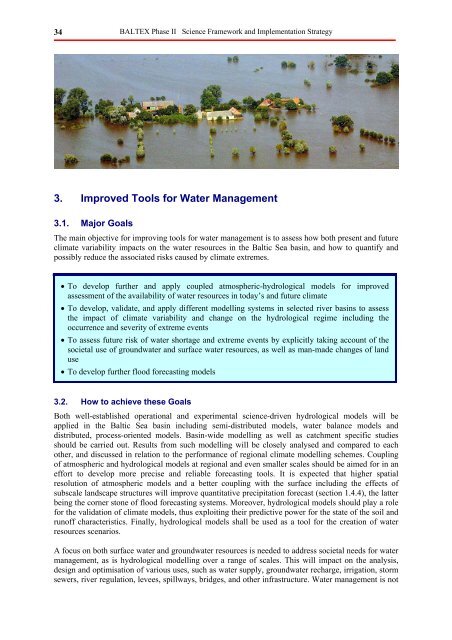BALTEX Phase II 2003 â 2012. Science Framework and ...
BALTEX Phase II 2003 â 2012. Science Framework and ...
BALTEX Phase II 2003 â 2012. Science Framework and ...
You also want an ePaper? Increase the reach of your titles
YUMPU automatically turns print PDFs into web optimized ePapers that Google loves.
34<br />
<strong>BALTEX</strong> <strong>Phase</strong> <strong>II</strong> <strong>Science</strong> <strong>Framework</strong> <strong>and</strong> Implementation Strategy<br />
3. Improved Tools for Water Management<br />
3.1. Major Goals<br />
The main objective for improving tools for water management is to assess how both present <strong>and</strong> future<br />
climate variability impacts on the water resources in the Baltic Sea basin, <strong>and</strong> how to quantify <strong>and</strong><br />
possibly reduce the associated risks caused by climate extremes.<br />
• To develop further <strong>and</strong> apply coupled atmospheric-hydrological models for improved<br />
assessment of the availability of water resources in today’s <strong>and</strong> future climate<br />
• To develop, validate, <strong>and</strong> apply different modelling systems in selected river basins to assess<br />
the impact of climate variability <strong>and</strong> change on the hydrological regime including the<br />
occurrence <strong>and</strong> severity of extreme events<br />
• To assess future risk of water shortage <strong>and</strong> extreme events by explicitly taking account of the<br />
societal use of groundwater <strong>and</strong> surface water resources, as well as man-made changes of l<strong>and</strong><br />
use<br />
• To develop further flood forecasting models<br />
3.2. How to achieve these Goals<br />
Both well-established operational <strong>and</strong> experimental science-driven hydrological models will be<br />
applied in the Baltic Sea basin including semi-distributed models, water balance models <strong>and</strong><br />
distributed, process-oriented models. Basin-wide modelling as well as catchment specific studies<br />
should be carried out. Results from such modelling will be closely analysed <strong>and</strong> compared to each<br />
other, <strong>and</strong> discussed in relation to the performance of regional climate modelling schemes. Coupling<br />
of atmospheric <strong>and</strong> hydrological models at regional <strong>and</strong> even smaller scales should be aimed for in an<br />
effort to develop more precise <strong>and</strong> reliable forecasting tools. It is expected that higher spatial<br />
resolution of atmospheric models <strong>and</strong> a better coupling with the surface including the effects of<br />
subscale l<strong>and</strong>scape structures will improve quantitative precipitation forecast (section 1.4.4), the latter<br />
being the corner stone of flood forecasting systems. Moreover, hydrological models should play a role<br />
for the validation of climate models, thus exploiting their predictive power for the state of the soil <strong>and</strong><br />
runoff characteristics. Finally, hydrological models shall be used as a tool for the creation of water<br />
resources scenarios.<br />
A focus on both surface water <strong>and</strong> groundwater resources is needed to address societal needs for water<br />
management, as is hydrological modelling over a range of scales. This will impact on the analysis,<br />
design <strong>and</strong> optimisation of various uses, such as water supply, groundwater recharge, irrigation, storm<br />
sewers, river regulation, levees, spillways, bridges, <strong>and</strong> other infrastructure. Water management is not













